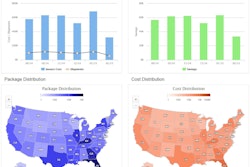
The past year has undeniably underscored the need for digital transformation. The global pandemic broadly necessitated a remote model for both workers and customers, making digitization of operations across companies and industries an imperative. While the changes we experienced highlighted vulnerabilities of various business operations, they also opened the door to explore new solutions.
As supply chains throughout the world were stretched to the limit in the face of reduced on-site workforce, logistics and distribution capacities, there emerged a new focus on end-to-end transparency as well as resiliency. This focus was critical for enabling proactive and rapid responses to imbalances in the supply chain. The use of artificial intelligence (AI) has become a must-have to mitigate today’s supply chain vulnerabilities, helping companies identify gaps and optimize processes for stronger, more efficient supply chains and ultimately greater customer experiences.
Prior to the pandemic, many supply chains depended on recent historical data to predict future outcomes. The pandemic disrupted this model; without a recent precedent for such a dramatic event, incumbent analytic approaches were challenged with identifying relevant data from which meaningful predictions could be gleaned. With AI informed by data, advanced pattern recognition techniques can sift out comparable market shock events and subtle shifts in data that a seasoned expert may overlook (such as those caused by hurricanes, wildfires, freighter grounded in the Suez Canal, etc.) that can then be employed to predict supply chain impacts based on current events, rather than purely relying on recent historical data. Across industries—distribution, healthcare, retail and more—data can drive AI, which can then help overcome supply chain challenges through a tradeoff of business outcome objectives and the insights of predicted assessments.
Let’s explore how AI has played a role in three different industries during the pandemic.
Wholesale distribution
A third-party wholesale distributor can benefit from AI integration by creating more visibility across a global supply chain network. By using data to indicate and assess demand, AI can help identify a different or more efficient supplier or distribution center to optimize the order fulfilment process.
For example, if one distribution center is completely shut down, it could throw off the entire supply chain. With AI, a manufacturer or retailer has the ability to determine the most efficient way to re-route product to minimize disruption throughout the supply chain. We saw this happen throughout the pandemic as distribution centers were hit by the Coronavirus disease (COVID-19). For those using AI, they were able to quickly shift and fulfill customer demand with minimal disruption.
Healthcare
In another industry, pharmacies can employ AI chatbots to communicate with customers. During the pandemic, limited staff at pharmacies coupled with limited use of chatbots often resulted in long wait times for customers looking to fill prescriptions. AI-enabled chatbots offer the opportunity to proactively communicate with customers, responding to their questions, gathering pertinent situational details and informing them of next steps. This technology can interpret customer input to provide helpful, dynamic responses, instead of pre-written template messages or “dead” communication.
For instance, if there’s disruption in the supply chain that causes a delay in the availability of a medication, the AI can provide recommended actions for healthcare providers as it relates to prioritizing patients’ prescription needs until that medication becomes available again. Additionally, the chatbot can triage patients’ inquiries to help mediate general inquiries and address those which require urgent response with proper guidance.
As an example, if Patient 1 has additional doses of medication available, but Patient 2 does not have any additional doses of medication remaining, a chatbot can gather information from each patient. With the data gleaned from the chatbot’s communications, the AI-enabled prescription fulfillment system can then recommend that a pharmacy prioritize Patient 2’s needs ahead of those of Patient 1. The chatbot can also provide responses to general inquiries from Patient 1 or Patient 2 around availability or further delays. In this way, chatbots, in their own right, can be a source of data that feeds the AI process.
Retail
In the retail supply chain, AI can help manage product inventories at distribution centers, anticipate customer purchase behavior and respond with proactive risk mitigation measures. This can be extraordinarily helpful in situations like the pandemic where consumer demand didn’t follow traditional cycles. With these prescriptive insights, retailers can maximize product availability and minimize out-of-stock situations, so that customers get the right product at the right place and at the right time.
What’s more, by mitigating potential risks with consumers, retailers can better forecast their own sales using AI. AI allows retailers to recognize merchant incentives for achieving target sales volumes and understand the market based on seasonal (e.g., back-to-school season) or market events (e.g., a merchant acquisition) by ingesting today’s data to provide future predictions.
In every industry, it’s important to remember that the presence of the AI outputs needs to be present where the user expects it and information is natural to consume for the user of the supply chain systems, which means it needs to be operationalized in context of the supply chain systems, in order to maximize its value.
With the proper framework, AI can be personalized and adapted to solve a specific business problem. On top of this, AI can support a more positive customer experience and yield lifetime customer value. With a cohesive, AI-enabled end-to-end supply chain strategy, enterprises are better equipped to accelerate time-to-market and time-to-value as well as provide an enhanced overall customer experience.
As the world begins to open again, supply chains must continue to adopt and integrate AI and machine learning to achieve success. Take the lessons of the past year, using AI to proactively identify and strengthen weak points and apply them to mitigate future risks, such as supply chain disruptions presented by hurricane or wildfire season. AI is no longer a value-add—it is a core component of building and maintaining visibility and resiliency throughout the entire supply chain.
Click here to hear more about AI in the supply chain:



















